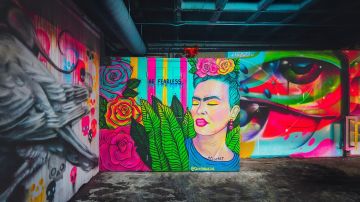7 Works of Art by Major Latinx Artists You Should Know
You may know about Vincent van Gogh, Monet, and Andy Warhol

Photo: Unsplash/@joshstyle
You may know about Vincent van Gogh, Monet, and Andy Warhol. A lot of these artists we learned about in school are household names. But do you know about some of the most important Latinx artists to ever create? The trailblazers, those influencing scores of others, breaking records, and starting movements? These creatives are an important part of our culture, history, present, and future.
Chances are, you do know the following artists, and their work. But we wanted to celebrate them and talk a bit about a piece of work each is known for. Because Latinx art should be taught in schools, celebrated on the same level as that of Europeans (or anyone else), and learned about. Articles like these help make that happen, for all things Latinx to be part of the mainstream.
wp_*posts
Untitled by Jean-Michel Basquiat (1981)
https://www.instagram.com/p/BUQRUU1lgzs/?taken-by=basquiatart
You may have heard of artist Jean-Michel Basquiat, but did you know he was Afro-Latino? The celebrated New York artist was the son of a Haitian father and Nuyorican mother. Basquiat’s art started as graffiti (under the name SAMO, along with friend Al Diaz), and landed him in galleries and the cover of the The New York Times Magazine. His work included elements from African art, and spoke on social issues, religion, race, and more. Last year, his Untitled painting sold for $110.5 million, becoming the most expensive piece of art by an American artist. It was also the first piece created after 1980 to be sold for over $100 million.
wp_*posts
The Two Fridas by Frida Kahlo (1939)
Frida Kahlo is another artistic icon—chances are, she’s your hero too. One of the Mexicana’s most famous and important works of art is Las dos Fridas. The work, painted in 1939, symbolizes two different facets of the artist—Frida in modern European dress, and traditional Tehuana dress. Heartbroken over her divorce from Diego Rivera, and as an intact woman, Frida Kahlo also mentioned that the painting was a recollection of an imaginary friend in childhood. In 1947, The Two Fridas sold to the Instituto Nacional de Bellas Artes in Mexico City for about $1000 (4,000 pesos). It was the most she received for a painting during her lifetime.
wp_*posts
Mona Lisa (1978), by Fernando Botero
Colombian artist Fernando Botero’s work is instantly recognizable, due to its voluminous, exaggerated proportions and satirical scenes. A perfect example of this is one of his most famous works, Mona Lisa. It shows a face we all know (painted by Leonardo da Vinci) and puts her through the Botero filter. In addition to paintings, Fernando Botero has created numerous bronze sculptures, which reside in places including Medellin, Paris, New York, Barcelona, Singapore, Armenia, and Berlin.
wp_*posts
Detroit Industry Murals (1933), by Diego Rivera
Diego Rivera is another major artist who you probably already know. He is one of the “big three” of the Mexican Muralist/Muralism movement (the other two being David Alfaro Siqueiros and Jose Clemente Orozco), having left his artistic legacy on murals in locations including San Francisco, New York, Cuernavaca, Mexico City, Chapingo, and Detroit. Rivera’s Detroit Industry Murals (consisting of 27 fresco panels) were completed in 1933, and are located at the Detroit Institute of Art. Considered one of Diego Rivera’s major works, they were given National Historic Landmark status in 2014.
wp_*posts
La Jungla (1943), by Wifredo Lam
Wifredo Lam was an Afro-Asian Latino artist, the son of a Chinese Cantonese father and an Afro-Cuban mother of Congolese, Indian, and Spanish descent. His work was a blend of African and Afro-Cuban art, Surrealism, and Cubism. Lam’s most famous work is La Jungla (The Jungle), which he painted in 1943. About the masterpiece he said, “I wanted with all my heart to paint the drama of my country, but by thoroughly expressing the Black spirit, the beauty of the plastic art of the Blacks. I knew I was running the risk of not being understood. … But a true picture has the power to set the imagination to work even if it takes time.”
wp_*posts
Bicho Parafuso sem fin (Md) (1962), by Lygia Clark
https://www.instagram.com/p/BjpvEgnhsJD/?tagged=lygiaclark
Brazilian artist Lygia Clark was a co-founder of the Neo-Concrete Movement. Part of what made Clark’s work so cool is that she wanted viewers to take part in it, so she created pieces that facilitated that. One such piece is Bicho, for which Lygia Clark is known. It is a golden aluminum sculpture created in 1962, with movable hinges, allowing participants to manipulate the shape in various ways.
wp_*posts
O Beijo (1995), by Beatriz Milhazes
Beatriz Milhazes is another Brasileira who has left her mark on the art world. Her technicolor, geometric, collaged pieces, with references to Brazilian culture and Modernism, have fetched millions of dollars. This has landed Milhazes spots on lists, including the 10 Most Expensive Living Female Artists and the Top 25 Most Collectible Living Latin American Artists.

















